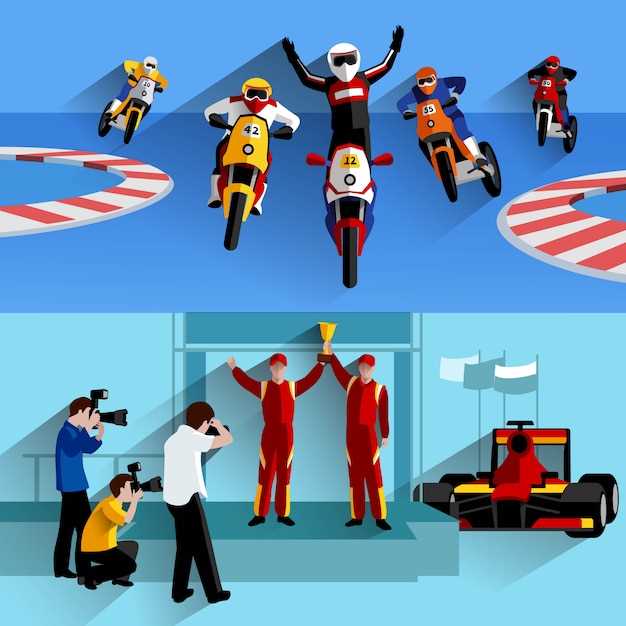
In the high-stakes world of motorsport, the pit stop serves as a critical juncture that can significantly influence the outcome of the race. Understanding the tactics involved in executing a successful pit stop can be the difference between victory and defeat. Teams must analyze various factors such as tire wear, fuel consumption, and track position to optimize their strategy.
Effective pit strategies are meticulously crafted to maximize performance and minimize time lost during a stop. Each element, from the timing of the pit entry to the precision of the tire change, is crucial. Teams must utilize real-time data and forecasts to make informed decisions about when to make their move, balancing the risk of losing valuable positions on the track against the potential gains of fresh tires and reduced fuel weight.
Moreover, communication and coordination among the crew during a pit stop are paramount. A well-rehearsed team can execute a full service in a matter of seconds, ensuring that every second counts. This article explores the intricate details of pit stop strategy and how teams strive for perfection to achieve maximum race performance.
Analyzing Pit Stop Timing for Optimal Tire Performance
In the highly competitive environment of motorsport, the efficiency of a pit stop can significantly influence the overall race outcome. One of the most critical aspects to consider is the timing of these stops, particularly concerning tire performance. Understanding the optimal moments for tire changes can provide teams with a tactical advantage, allowing for improved grip and speed on the track.
Race strategy often revolves around predicting tire degradation, which can vary based on several factors, including weather conditions, track surface, and driving style. By analyzing data from previous races, teams can determine the ideal window for a tire stop. Typically, the objective is to change tires when their performance begins to decline, which is generally observed through decreased lap times or increased difficulty in maintaining control of the car.
To optimize tire performance, teams employ various tactics, such as assessing the wear levels and temperature of tires while monitoring competitors’ pit strategies. By accurately predicting when their rivals will stop for tires, teams can execute their own stops to minimize time lost on the track. This foresight is critical in making the most of safety car periods or weather changes, as they can offer opportunities to change tires without losing significant track position.
Moreover, the specific choice of tire compounds plays a vital role in this analysis. Depending on the strategy–whether it leans toward a one-stop or two-stop approach–teams must evaluate the tire’s suitability for the track conditions and the remaining race distance. Timing the stop to switch to a faster compound at the right moment can lead to a significant performance boost and ultimately result in better finishing positions.
In conclusion, analyzing pit stop timing is a nuanced process that requires a deep understanding of both tire performance and race dynamics. Teams that excel in this area demonstrate a keen ability to adapt their strategies in real-time, ensuring that every second spent in the pit maximizes their potential on the racetrack. As motorsport continues to evolve, so will the tactics used in determining optimal pit stop moments, shaping the future of competitive racing.
Understanding Fuel Management During Pit Stops
Effective fuel management is crucial for achieving optimal race performance. During pit stops, teams must carefully calculate the amount of fuel needed to maximize speed while minimizing weight. Fuel weight influences a car’s acceleration and handling; thus, strategies must balance the need for sufficient fuel against the benefits of a lighter vehicle.
One key aspect of fuel management is timing. Executing pit stops at the right moment can help maintain competitive lap times and allow drivers to push harder without the fear of running out of fuel. Teams often analyze data from practice sessions and previous races to determine the best fuel load that will allow drivers to maintain pace without compromising their strategy.
Fuel conservation also plays a significant role in race endurance. Drivers and teams work together to manage fuel use throughout the race, employing techniques like lift-and-coast, where drivers ease off the throttle before entering corners to save fuel. This approach can extend the time between pit stops, providing a potential strategic advantage over competitors.
Pit stop efficiency is enhanced by precise communication between the driver and the pit crew. Quick decisions regarding fuel loads, whether to make additional adjustments, and how to handle tire changes can significantly affect overall race outcomes. With each second crucial, effective coordination is vital in ensuring that every pit stop retains maximum efficiency.
In conclusion, understanding fuel management during pit stops is essential for race teams aiming for success. Strategic planning, precise execution, and effective communication all contribute to achieving the best possible performance on the track.
Minimizing Human Error in Pit Crew Operations

The effectiveness of pit stop strategies heavily relies on the precision and efficiency of the pit crew. One critical aspect of ensuring maximum race performance is minimizing human error during these high-pressure operations. A well-executed pit stop can be the difference between winning and losing, making it vital to implement effective tactics aimed at reducing mistakes.
Training is fundamental in minimizing human error. Regular practice sessions allow crew members to develop muscle memory and enhance coordination. Simulating various race scenarios prepares the team to handle stress and maintain focus during actual pit stops. Incorporating consistent drills helps reinforce individual roles, ensuring that each member knows their specific tasks inside the pit.
Utilizing technology can also play a significant role in reducing human error. Advanced tools and communication systems facilitate real-time information sharing among crew members, ensuring seamless execution of stop protocols. For instance, using visual aids or digital displays to signal the arrival of the car can reduce confusion and streamline operations.
Another essential tactic is the establishment of clear and concise standard operating procedures (SOPs). These guidelines outline each phase of the pit stop, detailing tasks such as tire changes, fueling, and adjustments. Ensuring that each crew member understands these procedures minimizes uncertainty and enhances overall efficiency during the stop.
Additionally, fostering a culture of accountability encourages team members to perform at their best. When individuals take ownership of their roles, they are more likely to pay attention to detail and carry out tasks with precision. Periodic reviews and feedback sessions can help reinforce this culture, allowing team members to learn from past mistakes and improve continuously.
Lastly, implementing a contingency plan for potential errors can prevent minor mistakes from escalating into major issues. Developing protocols for addressing common pitfalls ensures that the crew is equipped to respond quickly, maintaining the overall pace of the race. By focusing on these tactics, teams can significantly reduce human error during pit stops, ultimately boosting their competitive edge on the track.
Utilizing Data Analytics for Pit Stop Decision Making
Data analytics plays a crucial role in optimizing pit stop strategies during a race. Teams leverage vast amounts of data to assess real-time performance, track conditions, and competitor actions, ensuring that every decision made in the pit is informed and strategic.
One of the primary areas where data analytics influences pit stop tactics is through predictive modeling. By analyzing historical race data, teams can anticipate when a tire change or fuel stop is most beneficial, factoring in variables such as tire degradation rates, fuel consumption, and the likelihood of safety cars. This foresight allows teams to execute stops at optimal moments, minimizing time lost on the track.
Furthermore, real-time telemetry data collected from the car during the race informs the team about the current performance levels. Metrics like lap times, tire temperatures, and engine performance provide valuable insights into when to initiate a pit stop. By continuously monitoring these statistics, teams can make quick decisions that align with their race strategies.
Effective communication is also enhanced through analytics. A dedicated data team analyses competitor pit stops and race behaviors, informing race engineers and drivers about potential tactical adjustments. For example, if a rival team makes an unplanned stop, it may prompt a strategic reaction to optimize the team’s own race performance.
| Data Type | Usage in Pit Stop Strategy |
|---|---|
| Historical Race Data | Identifying patterns for optimal pit stop timing |
| Real-Time Telemetry | Monitoring car performance for immediate decision making |
| Competitor Analysis | Adjusting tactics based on rivals’ strategies |
| Tire and Fuel Metrics | Determining the necessity and timing for stops |
In conclusion, the integration of data analytics into pit stop decision-making transforms race tactics significantly. By leveraging data, teams can ensure that pit stops are not just routine changes but calculated moves that enhance overall race performance.
Coordinating Driver and Crew Communication in Real-Time

Successful pit stop strategies rely heavily on effective communication between the driver and the crew. Real-time coordination is essential to maximize race performance and minimize the time spent during a stop. Here are key aspects to consider when enhancing communication:
- Use Technology: Implement advanced communication tools, such as radio systems and telemetry, to facilitate instant exchange of information. This allows the crew to relay vital data regarding tire conditions, fuel levels, and track status.
- Define Roles Clearly: Each team member should have a specific role during the pit stop. Ensuring everyone knows their responsibilities reduces confusion and enhances efficiency. Common roles include tire changers, fuelers, and data analysts.
- Establish Clear Signals: Signals should be predetermined and upheld during the race. This might include visual cues for the driver and specific phrases or codes for the crew. Consistency in communication ensures smoother interactions.
- Practice Tactics: Regular drills and simulations can prepare the team for various scenarios they might encounter during a race. This preparation allows the crew to execute their tasks with precision and confidence.
- Encourage Feedback: Promote an environment where both drivers and crew members can share input on communication efficiency. Learning from past races fosters continuous improvement in tactics and strategies.
In conclusion, the synchronization of driver and crew communication is vital for optimizing pit stops and overall race performance. By prioritizing effective communication, teams can implement strategies that reduce stop time and adapt to changing race conditions seamlessly.
Evaluating the Impact of Pit Stop Strategies on Overall Race Results
In motorsport, the efficacy of pit stop strategies can significantly influence the outcome of a race. Teams meticulously analyze various tactics to optimize their performance, seeking to minimize stop duration while maximizing tire and fuel management. Understanding the impact of these strategies is crucial for achieving the best results.
Key factors contributing to the effectiveness of pit stop strategies include:
- Timing: The moment a driver enters the pit lane can greatly affect their position on the track. Teams often monitor competitors to decide the optimal time for a stop.
- Type of Tires: Selecting the right tire compound is essential. Different conditions require specific types of tires, and the choice can affect traction and lap times.
- Fuel Load: Managing fuel levels influences the weight of the car. A lighter vehicle can increase speed, while longer stints on track can lead to tire degradation.
- Team Efficiency: The speed and efficiency of the crew during a stop are critical. A swift tire change and refueling can save valuable seconds, impacting overall race positioning.
The repercussions of pit stop strategies can be evaluated through several metrics:
- Lap Time Comparisons: Analyze lap times before and after stops to determine how effectively the tactics implemented are working.
- Position Changes: Monitor any shifts in position during and after the pit stop to assess the strategy’s success.
- Competitor Analysis: Study rival teams’ pit strategies to identify strengths and weaknesses that could be exploited.
- Long-Term Planning: Understand how short-term tactical decisions impact overall race goals and strategies over multiple pit stops.
Ultimately, a well-structured pit stop strategy can be the difference between victory and defeat. By evaluating the various elements and their cumulative effects on race results, teams can refine their approaches, leading to improved performance on the track.




